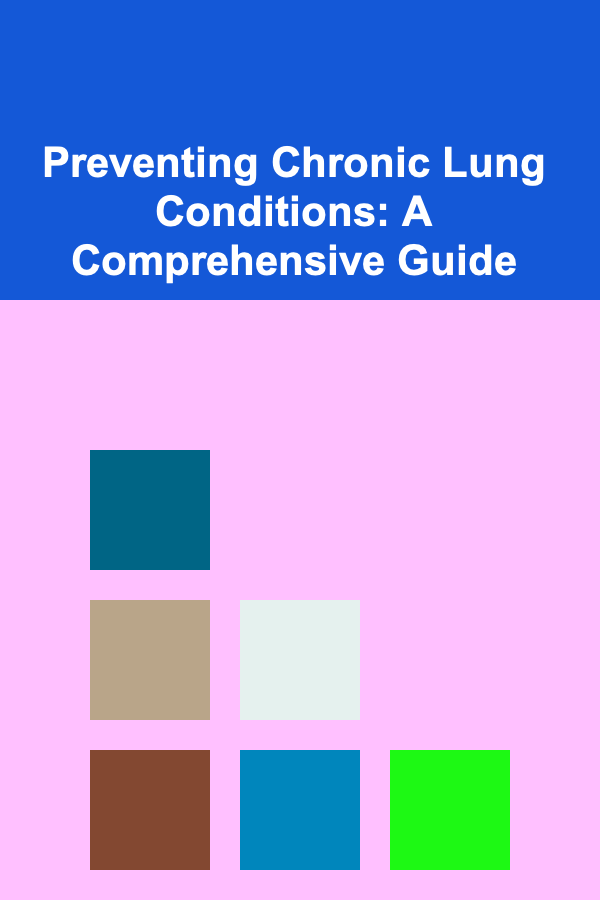
Preventing Chronic Lung Conditions: A Comprehensive Guide
ebook include PDF & Audio bundle (Micro Guide)
$12.99$8.99
Limited Time Offer! Order within the next:

Chronic lung conditions encompass a wide range of disorders that affect the lungs and airways, leading to persistent breathing difficulties and reduced quality of life. These conditions, including chronic obstructive pulmonary disease (COPD), asthma, cystic fibrosis, pulmonary fibrosis, and bronchiectasis, are often progressive and can significantly impact an individual's health and longevity. While some factors contributing to chronic lung conditions, such as genetics, may be unavoidable, many others are modifiable. This comprehensive guide explores the key strategies and lifestyle modifications that can significantly reduce the risk of developing chronic lung conditions or slow their progression.
Understanding Chronic Lung Conditions
Before delving into preventive measures, it's crucial to understand the nature of chronic lung conditions and their common causes. These conditions are generally characterized by inflammation and/or damage to the lungs and airways, leading to airflow obstruction, difficulty breathing, persistent cough, mucus production, and fatigue. Different conditions have different underlying mechanisms and specific symptoms.
- Chronic Obstructive Pulmonary Disease (COPD): Primarily caused by long-term exposure to irritants, especially cigarette smoke, COPD encompasses emphysema (damage to the air sacs in the lungs) and chronic bronchitis (inflammation and narrowing of the bronchial tubes).
- Asthma: A chronic inflammatory disease of the airways characterized by reversible airflow obstruction, airway hyperresponsiveness, and inflammation. Triggers vary but can include allergens, irritants, exercise, and respiratory infections.
- Cystic Fibrosis (CF): A genetic disorder that causes the body to produce thick and sticky mucus that can clog the lungs and other organs, leading to recurrent infections and lung damage.
- Pulmonary Fibrosis: A progressive scarring of the lung tissue, making it difficult to breathe. The cause is often unknown (idiopathic pulmonary fibrosis), but can also be associated with autoimmune diseases, environmental exposures, and certain medications.
- Bronchiectasis: Permanent widening and thickening of the airways, making it difficult to clear mucus and increasing the risk of recurrent infections.
Understanding the specific risks and potential triggers for each condition is essential for developing effective prevention strategies.
The Cornerstones of Lung Health Prevention
Preventing chronic lung conditions involves a multifaceted approach that addresses various risk factors and promotes overall lung health. The following are some of the most critical strategies:
1. Smoking Cessation: The Single Most Important Step
Smoking is the leading cause of COPD and a major risk factor for other lung conditions, including lung cancer, asthma exacerbations, and pulmonary fibrosis. Quitting smoking is the single most important step you can take to protect your lungs and improve your overall health.
- Understand the Risks: Educate yourself about the devastating effects of smoking on your lungs and overall health. Consider the long-term consequences and the impact on your quality of life.
- Set a Quit Date: Choose a specific date to quit and prepare yourself mentally and physically.
- Seek Support: Enlist the support of friends, family, or a support group. Consider joining a smoking cessation program or working with a healthcare professional.
- Nicotine Replacement Therapy (NRT): Use nicotine patches, gum, lozenges, inhalers, or nasal sprays to reduce nicotine cravings and withdrawal symptoms.
- Medications: Talk to your doctor about prescription medications, such as bupropion (Zyban) or varenicline (Chantix), which can help reduce cravings and withdrawal symptoms.
- Avoid Triggers: Identify situations or activities that trigger your urge to smoke and avoid them, or develop coping strategies to manage them.
- Stay Active: Regular physical activity can help reduce cravings and improve your mood.
- Be Patient and Persistent: Quitting smoking can be challenging, and relapses are common. Don't give up if you slip up. Learn from your mistakes and keep trying.
- Avoid Secondhand Smoke: Even exposure to secondhand smoke can be detrimental to lung health, especially for children and individuals with pre-existing lung conditions. Advocate for smoke-free environments in your home, workplace, and community.
2. Avoiding Environmental and Occupational Exposures
Exposure to various environmental and occupational pollutants can significantly increase the risk of developing chronic lung conditions. Minimizing these exposures is crucial for protecting your lungs.
- Air Pollution: Avoid or minimize exposure to air pollution, especially on days with high ozone or particulate matter levels. Check air quality reports in your area and take precautions, such as staying indoors, using air purifiers, and avoiding strenuous outdoor activities.
- Radon: Test your home for radon, a naturally occurring radioactive gas that can cause lung cancer. If radon levels are high, install a radon mitigation system.
- Asbestos: Asbestos exposure can cause asbestosis, lung cancer, and mesothelioma. If you work in an industry where asbestos is present, follow safety protocols and wear appropriate protective equipment. If you suspect asbestos in your home, consult with a qualified professional for safe removal or encapsulation.
- Dust and Fumes: Avoid or minimize exposure to dust, fumes, and other irritants in the workplace. Use appropriate ventilation and wear respiratory protection, such as masks or respirators, when necessary. Occupations with high risk include mining, construction, agriculture, and manufacturing.
- Mold: Mold exposure can trigger asthma and other respiratory problems. Address mold growth in your home promptly by cleaning affected areas and fixing moisture problems.
- Volatile Organic Compounds (VOCs): Minimize exposure to VOCs, which are emitted from paints, cleaning products, and other household items. Choose low-VOC products and ensure adequate ventilation when using them.
- Burning Biomass: Avoid or limit exposure to smoke from burning wood, crop residue, or other biomass for heating or cooking. These practices contribute significantly to indoor and outdoor air pollution, particularly in developing countries. If biomass burning is unavoidable, ensure adequate ventilation and consider using cleaner-burning stoves.
3. Preventing and Managing Respiratory Infections
Respiratory infections, such as influenza (the flu), pneumonia, and respiratory syncytial virus (RSV), can damage the lungs and increase the risk of developing chronic lung conditions, especially in individuals with pre-existing lung problems. Taking steps to prevent and manage these infections is essential.
- Vaccination: Get vaccinated against influenza (the flu) annually and pneumonia (pneumococcal vaccine) as recommended by your doctor. These vaccines can significantly reduce your risk of contracting these infections and their complications. COVID-19 vaccination is also crucial to prevent severe respiratory illness.
- Hand Hygiene: Wash your hands frequently with soap and water, especially after touching public surfaces or being around sick people. Use hand sanitizer when soap and water are not available.
- Avoid Close Contact: Avoid close contact with people who are sick. If you are sick, stay home to prevent spreading the infection to others.
- Cover Your Cough: Cover your mouth and nose with a tissue when you cough or sneeze, and dispose of the tissue properly. If you don't have a tissue, cough or sneeze into your elbow.
- Boost Your Immune System: Maintain a healthy lifestyle, including a balanced diet, regular exercise, and adequate sleep, to boost your immune system and help your body fight off infections.
- Early Treatment: Seek medical attention promptly if you develop symptoms of a respiratory infection. Early treatment with antiviral medications or antibiotics can help reduce the severity and duration of the infection and prevent complications.
4. Maintaining a Healthy Lifestyle
A healthy lifestyle plays a crucial role in promoting lung health and reducing the risk of chronic lung conditions. This includes maintaining a healthy weight, eating a balanced diet, exercising regularly, and managing stress.
- Healthy Weight: Maintain a healthy weight to reduce the strain on your lungs and improve your breathing. Obesity can contribute to respiratory problems and worsen existing lung conditions.
- Balanced Diet: Eat a balanced diet rich in fruits, vegetables, and whole grains. These foods provide essential nutrients that support lung health and immune function. Consider incorporating foods rich in antioxidants, such as berries, spinach, and nuts, which can help protect against lung damage.
- Regular Exercise: Engage in regular physical activity to strengthen your respiratory muscles and improve your lung function. Aim for at least 30 minutes of moderate-intensity exercise most days of the week. Consult with your doctor before starting a new exercise program, especially if you have a pre-existing lung condition.
- Hydration: Drink plenty of fluids to keep your airways moist and help loosen mucus.
- Stress Management: Manage stress through relaxation techniques such as yoga, meditation, or deep breathing exercises. Stress can worsen respiratory symptoms and trigger asthma attacks.
5. Regular Medical Checkups and Lung Function Testing
Regular medical checkups and lung function testing can help detect early signs of lung disease and allow for timely intervention. This is especially important for individuals with a family history of lung disease, those who have been exposed to lung irritants, and those who have a history of respiratory infections.
- Regular Checkups: Schedule regular checkups with your doctor to monitor your lung health and discuss any concerns you may have.
- Lung Function Tests: Undergo lung function tests, such as spirometry, to assess your lung capacity and airflow. Spirometry can help detect early signs of COPD and asthma.
- Chest X-rays or CT Scans: Consider chest X-rays or CT scans if you have a history of smoking or exposure to lung irritants, or if you have symptoms of lung disease.
- Early Detection and Treatment: Early diagnosis is vital. If you experience persistent cough, shortness of breath, wheezing, or chest tightness, seek prompt medical attention. Early intervention can slow the progression of lung diseases and improve outcomes.
6. Managing Existing Lung Conditions
For individuals who already have a chronic lung condition, proper management is crucial to prevent exacerbations, slow disease progression, and improve quality of life.
- Adherence to Treatment: Follow your doctor's instructions carefully and take your medications as prescribed. This includes inhalers, oral medications, and other therapies.
- Pulmonary Rehabilitation: Participate in a pulmonary rehabilitation program to learn breathing techniques, exercise strategies, and self-management skills. Pulmonary rehabilitation can improve your breathing, reduce your symptoms, and enhance your quality of life.
- Avoid Triggers: Identify and avoid triggers that worsen your lung condition, such as allergens, irritants, and cold air.
- Monitor Symptoms: Monitor your symptoms closely and report any changes to your doctor.
- Action Plan: Develop an action plan with your doctor to manage exacerbations and prevent them from becoming severe.
- Oxygen Therapy: If you have low blood oxygen levels, use supplemental oxygen as prescribed by your doctor.
- Regular Monitoring: Regular follow-up appointments with a pulmonologist are vital for monitoring disease progression and adjusting treatment plans accordingly.
7. Specific Considerations for Children
Children are particularly vulnerable to the effects of air pollution and respiratory infections. Protecting children's lung health is essential for their long-term well-being.
- Avoid Secondhand Smoke: Protect children from exposure to secondhand smoke. Smoking in the home or car can significantly increase a child's risk of developing asthma, respiratory infections, and other lung problems.
- Breastfeeding: Breastfeed infants for as long as possible, as breast milk provides antibodies that protect against respiratory infections.
- Vaccination: Ensure that children are vaccinated against influenza, pneumonia, and other respiratory illnesses.
- Minimize Air Pollution Exposure: Minimize children's exposure to air pollution, especially on days with high ozone or particulate matter levels.
- Avoid Allergens: Identify and avoid allergens that trigger asthma in children.
- Early Intervention: Seek medical attention promptly if a child develops symptoms of a respiratory infection or asthma.
8. The Importance of Research and Innovation
Continued research and innovation are crucial for developing new strategies to prevent and treat chronic lung conditions. Support research efforts aimed at understanding the causes of lung disease and developing new therapies.
- Participate in Clinical Trials: Consider participating in clinical trials to help researchers develop new treatments for lung conditions.
- Support Research Funding: Support organizations that fund research on lung disease.
- Stay Informed: Stay informed about the latest research findings and advancements in lung health.
Conclusion
Preventing chronic lung conditions requires a proactive and comprehensive approach that addresses various risk factors and promotes overall lung health. By quitting smoking, avoiding environmental and occupational exposures, preventing and managing respiratory infections, maintaining a healthy lifestyle, and seeking regular medical checkups, you can significantly reduce your risk of developing chronic lung conditions or slow their progression. Early detection and proper management are crucial for individuals who already have a lung condition. By taking these steps, you can protect your lungs and enjoy a healthier, more active life.
This information is intended for general knowledge and informational purposes only, and does not constitute medical advice. It is essential to consult with a qualified healthcare professional for any health concerns or before making any decisions related to your health or treatment.
Reading More From Our Other Websites
- [Personal Care Tips 101] How to Choose a Natural Deodorant That Truly Works for You
- [Personal Investment 101] How to Make Money with AI-Powered Deep Learning Solutions
- [Personal Investment 101] How to Identify if Your Financial Advisor is Truly a Fiduciary Financial Advisor: Key Questions to Ask
- [Personal Investment 101] How to Rebalance Your Investment Portfolio for Optimal Performance
- [Home Cleaning 101] How to Maintain a Clean Home with a Busy Family
- [Home Pet Care 101] Why Microchipping Your Pet is a Must
- [Survival Kit 101] How to Choose the Best Essential Survival Tools for a Bug Out Bag
- [Home Maintenance 101] How to Maintain Your Home's Homeowner's Warranty and Documentation
- [Home Family Activity 101] How to Host a Family Karaoke Night Without Leaving Home
- [Home Budget 101] How to Manage Your Budget When Living Paycheck to Paycheck

How to Build a Home Storage System That Grows with Your Family
Read More
How to Create a Checklist for Timing Your Social Media Posts
Read More
How to Save for a Down Payment on a House
Read More
How to Save Space in Your Home Office with Minimalist Solutions
Read More
How to Design a Daily Meditation Checklist for Optimal Results
Read More
10 Tips for Creating a Personalized Inspirational Quote Wall
Read MoreOther Products

How to Build a Home Storage System That Grows with Your Family
Read More
How to Create a Checklist for Timing Your Social Media Posts
Read More
How to Save for a Down Payment on a House
Read More
How to Save Space in Your Home Office with Minimalist Solutions
Read More
How to Design a Daily Meditation Checklist for Optimal Results
Read More